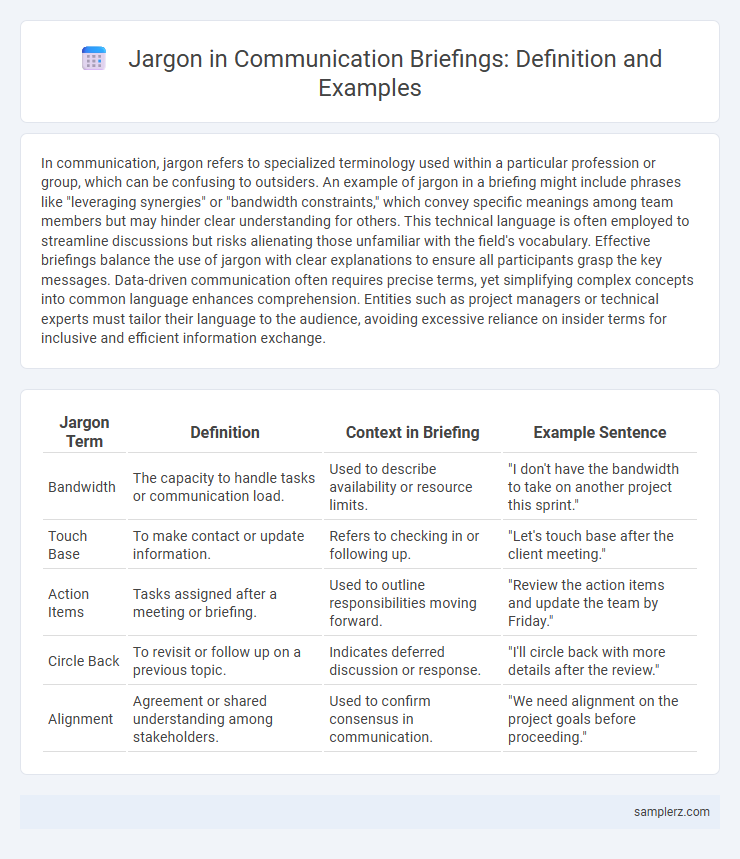In communication, jargon refers to specialized terminology used within a particular profession or group, which can be confusing to outsiders. An example of jargon in a briefing might include phrases like "leveraging synergies" or "bandwidth constraints," which convey specific meanings among team members but may hinder clear understanding for others. This technical language is often employed to streamline discussions but risks alienating those unfamiliar with the field's vocabulary. Effective briefings balance the use of jargon with clear explanations to ensure all participants grasp the key messages. Data-driven communication often requires precise terms, yet simplifying complex concepts into common language enhances comprehension. Entities such as project managers or technical experts must tailor their language to the audience, avoiding excessive reliance on insider terms for inclusive and efficient information exchange.
Table of Comparison
| Jargon Term | Definition | Context in Briefing | Example Sentence |
|---|---|---|---|
| Bandwidth | The capacity to handle tasks or communication load. | Used to describe availability or resource limits. | "I don't have the bandwidth to take on another project this sprint." |
| Touch Base | To make contact or update information. | Refers to checking in or following up. | "Let's touch base after the client meeting." |
| Action Items | Tasks assigned after a meeting or briefing. | Used to outline responsibilities moving forward. | "Review the action items and update the team by Friday." |
| Circle Back | To revisit or follow up on a previous topic. | Indicates deferred discussion or response. | "I'll circle back with more details after the review." |
| Alignment | Agreement or shared understanding among stakeholders. | Used to confirm consensus in communication. | "We need alignment on the project goals before proceeding." |
Understanding Jargon in Briefings
Understanding jargon in briefings enhances clarity by using specialized terminology familiar to the audience. For example, in a project management briefing, terms like "scope creep," "milestones," and "deliverables" convey specific concepts efficiently. Recognizing these jargon terms prevents miscommunication and ensures all participants align on key objectives.
Common Jargon Terms Used in Briefings
Common jargon terms used in briefings include "action items," referring to specific tasks assigned during the meeting, "stakeholders," denoting individuals or groups with vested interests, and "deliverables," which indicate the expected outputs or results. These terms streamline communication by providing concise, standardized language that enhances understanding and efficiency among participants. Mastery of such jargon is essential for effective and professional briefing sessions.
Why Jargon Appears in Professional Briefings
Jargon appears in professional briefings to create a shared understanding among experts, ensuring efficient and precise communication within specialized fields. It helps convey complex concepts quickly without lengthy explanations, saving time during critical decision-making processes. However, excessive use of jargon can hinder clarity for non-expert stakeholders, highlighting the importance of audience awareness in briefing communication.
Impact of Jargon on Briefing Clarity
Jargon such as "ROI," "KPIs," and "bandwidth" can obscure critical information during briefings, reducing clarity and causing misunderstandings among diverse audiences. Excessive use of technical terms often alienates participants unfamiliar with the specialized language, leading to decreased engagement and misinterpretation of key messages. Streamlining communication by minimizing jargon enhances comprehension, ensuring that objectives and expectations are clearly conveyed.
Industry-Specific Jargon Examples in Briefings
Industry-specific jargon in briefings enhances clarity among professionals by using terms like "KPIs" (Key Performance Indicators) in marketing, "SOW" (Statement of Work) in project management, and "SKU" (Stock Keeping Unit) in supply chain discussions. These precise expressions streamline communication and reduce misunderstandings during strategic planning and operational updates. Familiarity with such jargon enables stakeholders to quickly grasp complex concepts tailored to their sector.
Decoding Technical Language During Briefings
Decoding technical language during briefings involves translating industry-specific jargon into clear, accessible terms to ensure all participants understand the message. Common examples include acronyms like "API" (Application Programming Interface) or terms like "bandwidth" used figuratively to describe capacity rather than data transfer. Effective communication requires converting these specialized expressions into straightforward language tailored to the audience's knowledge level.
Best Practices for Explaining Jargon in Briefings
When explaining jargon in briefings, use clear definitions and relatable examples to ensure audience understanding. Avoid overwhelming listeners with technical terms by breaking down complex concepts into simple language. Incorporate visual aids and encourage questions to reinforce clarity and engagement.
Jargon vs. Plain Language in Team Briefings
In team briefings, jargon such as "synergize" or "bandwidth" often creates confusion and impedes clear communication, whereas plain language promotes understanding and efficiency. Using straightforward terms like "work together" and "capacity" ensures all team members grasp the message quickly, reducing misunderstandings and increasing productivity. Clear communication in briefings drives collaboration and aligns team objectives effectively.
Consequences of Misusing Jargon in Briefings
Misusing jargon in briefings causes confusion, leading to misinterpretation of critical information and impaired decision-making. Employees unfamiliar with specialized terms may experience decreased engagement and reduced productivity. Clear communication is essential to ensure all participants fully understand the briefing's purpose and directives.
How to Minimize Jargon for Effective Briefings
Using clear, concise language during briefings enhances understanding and engagement, reducing confusion caused by industry-specific jargon. Replacing technical terms with simple explanations or visual aids helps convey key messages effectively to diverse audiences. Encouraging questions and feedback further ensures clarity and minimizes misinterpretation in communication.

example of jargon in briefing Infographic
 samplerz.com
samplerz.com